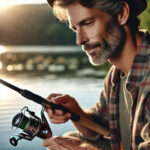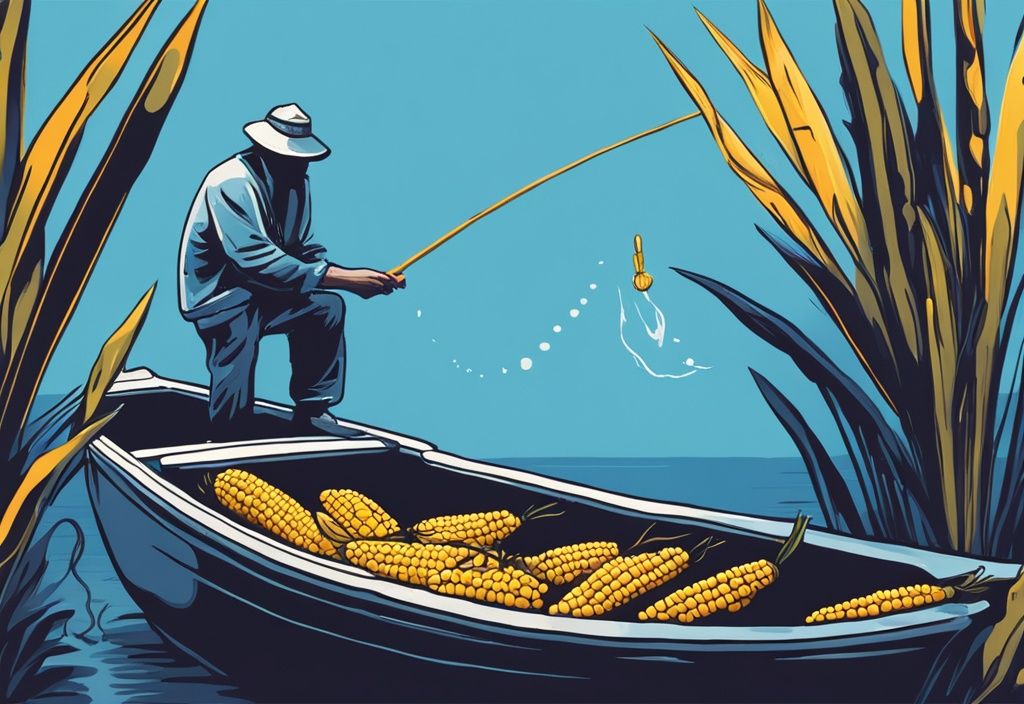Ever cast your line using a kernel of corn and questioned its legality? You’re not alone, this common bait is a center point of a fiery debate among us anglers and regulators. Turns out, the simple corn kernel carries a whole lot of legal and environmental baggage.
Now, you may have heard mixed things – some states greenlight corn as hook bait, while others slap fines for even considering it. The whole hullabaloo comes down to the serious effect our favorite canned vegetable can have on underwater life and fish wellbeing.
In this piece, we’ll break down the corn conundrum, exploring the rules, the reasons behind them, and how staying in line jazzes up our fishing experiences. Let’s dive in and get to the bottom of why fishing with corn can land you in hot water.
Understanding the Legal Reasons Behind Corn Fishing
Using corn as bait in fishing is a topic surrounded by a multitude of laws and local regulations. Below, we explore the various legal aspects of corn fishing, delving into specific state laws and the nuanced debate between chumming and baiting.
Legislation for Corn Fishing in Different States
Using corn as bait can get tricky due to strict regulations that vary by state. Some states prohibit using corn altogether because of environmental concerns. Take Rhode Island, for instance—they’ve laid down clear rules against it. In states like California, Colorado, Hawaii, Idaho, Kentucky, Maine, Michigan, Minnesota, Nevada, North Dakota, Oregon, South Carolina, Utah, and Vermont, chumming with corn is a big no-no. These laws aim to protect delicate aquatic ecosystems from disruption.
Now, if you think violating these regulations is a minor offense, think again. Penalties can range from hefty fines to fishing license suspensions, and in severe cases, even criminal charges. However, it’s not all doom and gloom. Fishing with corn is not outright illegal everywhere—it seriously depends on where you’re casting your line. Always double-check local fishing laws to stay out of trouble and fish responsibly.
The Debate: Chumming vs. Baiting with Corn
Let’s settle some confusion: the whole hullabaloo about the illegality of fishing with corn often boils down to the battle between chumming and baiting. Chumming means scattering bait, like corn, into the water to lure fish. This method is restricted in many areas because it can mess with the ecosystem. Overfeeding fish with scattered corn can change their behavior and throw off the natural balance of the water body.
Baiting, on the other hand, involves placing a small amount of corn on a hook. This practice is usually deemed less harmful and often remains legal. The main issue that makes corn fishing illegal in many states is its link to chumming, not baiting. Understanding this distinction is crucial for staying within the law and keeping our waterways healthy. Knowing your local laws and definitions ensures not only a legal fishing trip but also a respectful nod to nature’s well-being.
By adhering to these tips and always staying updated on the regulations, you can enjoy the thrill of fishing while preserving the environment. Tight lines, everyone!
The Environmental Consequences of Fishing with Corn
When we talk about fishing with corn, we’re diving into some pretty heavy environmental topics. Let’s break down why this seemingly innocent practice can actually cause some real harm to our beloved fishing spots.
The Impact of Corn Bait on Aquatic Ecosystems
Using corn as bait in fishing stirs up several environmental issues, which is a big reason why it’s illegal in many places.
Imagine corn drawing fish away from their native food—this creates a ruckus in the ecosystem. Fish start ignoring their natural munchies, leading to a shift in their behavior and messing up their role in the aquatic food web.
And, let’s face it, corn isn’t a part of a fish’s usual menu. This odd diet can mess with their health and even their ability to reproduce. Over time, fish chowing down on non-native grub like corn can disrupt fish populations, throwing biodiversity out of whack. This problem hits hard in fragile ecosystems where keeping native species around is key. Many regions have placed strict bait bans, including the use of corn, to protect these vulnerable waters and ensure the natural balance is maintained.
The Aftermath of Uneaten Corn in the Water
Picture this: leftover corn littering the water, leading to some nasty environmental headaches. This is another heavy hitter in the list of reasons why fishing with corn faces regulations. Corn scraps attract unwanted critters like rodents and birds, bringing along more pollutants and shaking up the local wildlife scene. When corn decomposes in water, it gobbles up oxygen, harming all forms of aquatic life. These dead zones where oxygen levels plummet—where fish and other marine creatures just can’t survive—paint a grim picture.
Due to these harsh impacts, many places have clamped down on corn chumming and baiting to safeguard ecological balance and encourage sustainable fishing. These rules highlight the essence of responsible fishing, maintaining the vibrant and healthy aquatic ecosystems we all cherish.
Can Corn Harm Fish? Unpacking the Risks
Unveiling the hidden dangers of using corn as bait in fishing reveals much about why it is illegal in some areas. Let’s dive into the specific risks involved.
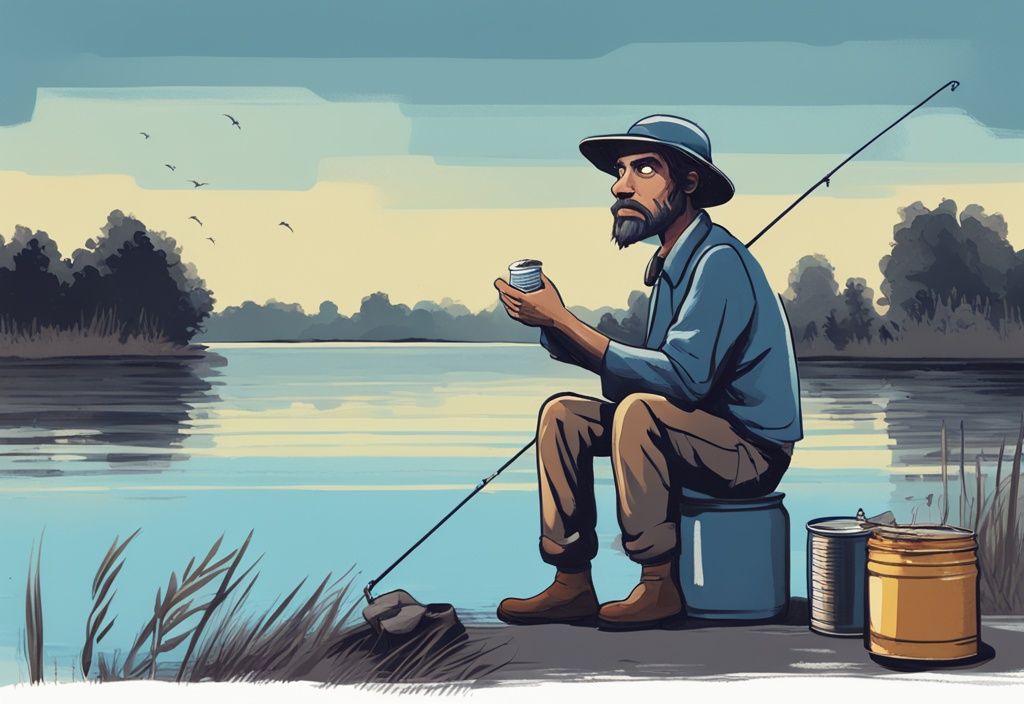
Digestive Complications in Fish Due to Corn
Picture this: you’ve cast your line and feel that familiar tug, but what if your choice of bait could harm the very creature you seek? That’s the conundrum with corn. It might surprise you to learn that corn can lead to overfeeding, causing fish to gain unhealthy weight and ultimately putting their health on the line. Many fish species, bless their little hearts, struggle to digest corn. The undigested kernels can jam up their intestines or stomachs, sometimes with fatal results. The Benner Spring Fish Research Station found that fish on an all-corn diet didn’t immediately perish, but their growth took a serious hit. So, while corn isn’t an instant killer, its long-term dietary effects are nothing to scoff at.
Species-Specific Vulnerabilities
Now, not all fish are built alike—some can handle corn better than others, bringing us to why using corn is illegal in some places. Take trout, for instance. These fish can’t digest corn and suffer severe, sometimes deadly, consequences. On the flip side, carp can tackle corn somewhat better. But let’s be real: even carp aren’t entirely safe. Whole kernels can clog up their systems, leading to a tragic end. Despite these risks, corn remains a go-to bait for many anglers targeting carp, bullhead catfish, bass, and sunfish. Knowing which species can tolerate corn and which can’t is crucial for all of us looking to fish responsibly and safeguard our aquatic friends.
Mistaken Beliefs Around Corn Fishing
Perceived Versus Concrete Damage: What Does Science Say?
There’s a common myth floating around that corn is bad news for fish because it’s hard for them to digest. Sure, some fish, like trout, do struggle with processing corn, which can lead to some tummy troubles. But here’s the kicker: research shows that the occasional nibble on a corn kernel off a hook isn’t likely to do serious harm. It’s crucial to separate incidental snacking from regular feeding. When used sparingly as bait, corn doesn’t pose a major threat to fish or their watery world. The real issue crops up when corn is dumped in large quantities—this can mess with natural eating habits and cause long-term health problems for fish.
Are Existing Laws Overstated or Outdated?
The whole confusion about whether you’re allowed to use corn as bait usually comes from old laws and different regional rules. A lot of the time, these rules ban things like chumming, which means throwing a bunch of corn or other stuff in the water to lure fish. This can mess up the environment by overfeeding fish and disrupting the ecosystem.
However, if you’re just popping a few kernels on a hook, you’re generally in the clear, even in places like Colorado. The main difference here is how much corn you’re using and what you’re doing with it. While spraying corn around is mostly banned to protect aquatic life, using a few kernels for personal fishing is usually fine. Anglers need to get this distinction straight to follow local fishing rules.
Ethical Dilemmas: Corn as Bait
Fishing with corn: it’s a topic that ensures the angling community is never short on debate. Some swear by it, while others couldn’t disagree more passionately. In this section, we’ll dive into both perspectives and explore some responsible alternatives.
Views of Anglers: The Pro-Corn & Anti-Corn Camps
Among avid fishers, the use of corn as bait sparks intense discussions. Those in the pro-corn camp argue that corn is not only practical but highly effective, especially when targeting fish species like carp and bullhead catfish. It’s cheap, readily available, and easy for even beginners to use, making it a favorite for many.
On the flip side, the anti-corn camp raises some serious points. They emphasize that corn is not part of the natural diet for most fish and could potentially disrupt local ecosystems. It’s not just about catching fish; it’s about maintaining a sustainable practice. These anglers are concerned that introducing non-native bait like corn could bring more harm than good, affecting both fish and their habitats.
Responsible Fishing: Safer Alternatives to Corn
If you’re fishing in areas where using corn as bait is illegal, or if you just want to be kinder to our aquatic friends, there are plenty of alternative options. Worms and insects are classic choices that fish are more accustomed to in their natural diets. Not only do they pose less risk of digestive issues for the fish, but they are also generally more eco-friendly.
For those looking to try something different, fishing stores offer specially formulated baits that are both effective and environmentally safer. These baits often mimic the look and smell of corn but are made from materials that are easier for fish to digest. Brands like Berkley and Pautzke have developed imitation corn products designed to reduce environmental impact while still ensuring a successful catch.
So, next time you’re gearing up for a fishing trip, consider these alternatives. Familiarize yourself with local regulations and always aim to fish responsibly. After all, we want to enjoy the thrill of the catch without compromising the health of our aquatic ecosystems.
Staying Legal: Complying with Local Fishing Codes
As an experienced angler, it’s essential to stay on the right side of the law and support sustainable fishing. What’s the deal with fishing with corn? Well, laws about it can be a bit of a mixed bag.
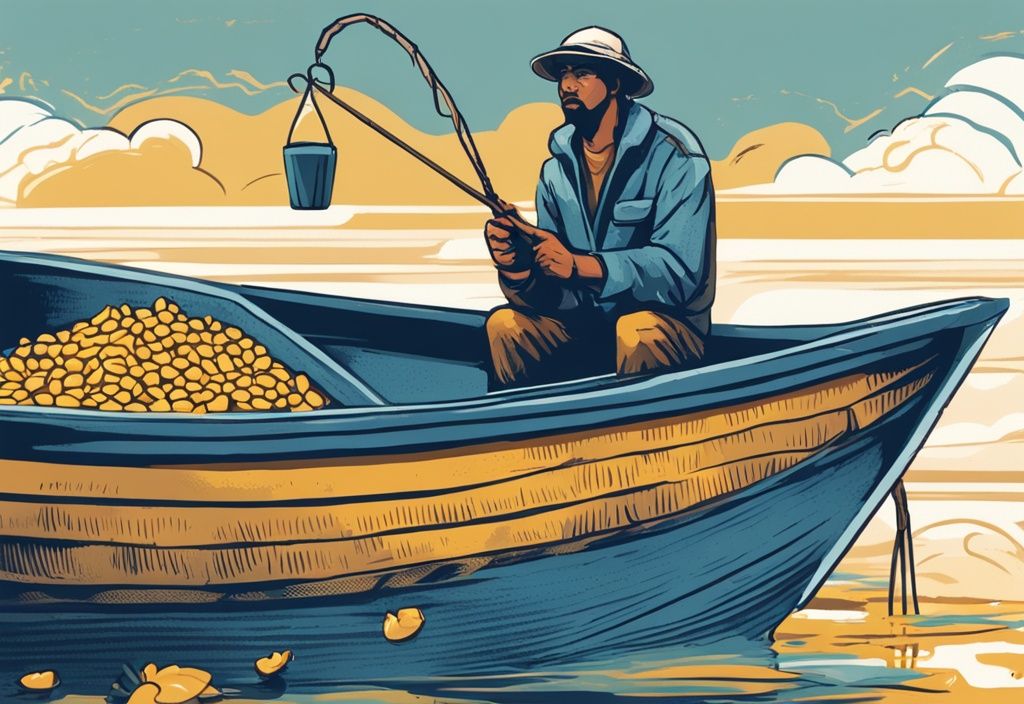
Some places in the United States, and even around the world, have specific regulations about using corn as bait. And trust me, you don’t want to be caught off guard. These rules are designed to keep our aquatic ecosystems healthy, prevent non-native species from wreaking havoc, and ensure the fish populations thrive.
Keeping Up-To-Date With Local Fishing Regulations
Imagine this: You’ve packed your gear, planned your trip, and the lake is calling your name. But before you cast that first line, make sure you’re up to speed with the local fishing regulations. Nothing throws a wrench in a perfect fishing day like an unexpected fine or penalty.
Checking in with local wildlife agencies or chatting with a seasoned fishing guide can provide you with the latest rules on using corn as bait. These resources are gold—use them to stay compliant and keep your fishing adventures trouble-free.
Being well-informed isn’t just about avoiding fines; it’s about being responsible. Knowing the local regulations helps protect the delicate balance of the ecosystem and ensures that the fishing scene is preserved for the next generation of anglers.
Eco-friendly and Legal Fishing Practices to Follow
Okay, so you’ve got the legalities down, but what about going green? Before you toss that corn into the water, it’s important to understand the environmental impact. Some regions may have bans on chumming with corn or even using it as bait, so it’s crucial to know what’s what.
When it comes to eco-friendly fishing, consider alternatives like worms, insects, or those specially formulated baits from fishing stores. They’re often crafted to be safer for fish and less disruptive to their natural behaviors. Plus, they help keep the biodiversity of our favorite fishing spots intact.
By opting for environmentally sustainable baits, you’re not just following the rules—you’re playing a part in preserving the beauty and health of our water bodies. This way, fishing remains a joy for all, now and in the future.
So next time you’re out there, remember—stay legal, stay sustainable, and keep the spirit of fishing alive!
Conclusion
The regulations surrounding corn fishing are meticulously designed to protect fish populations and maintain the health of aquatic ecosystems. By understanding why laws exist, particularly concerning the use of corn bait, anglers can help ensure a sustainable and balanced environment.
Why is fishing with corn illegal? In many places, corn fishing regulations stem from environmental and ecological concerns. Corn is a non-native food for many fish species, and improper use can lead to serious disruptions. Chumming with corn, which involves scattering large quantities of corn in the water to attract fish, can cause overfeeding. This overfeeding not only disrupts normal fish behaviors but can also lead to water pollution as uneaten corn decomposes, reducing vital oxygen levels in the water and harming aquatic life.
These laws aren’t just about fish health but about preserving entire aquatic ecosystems. Using corn can attract fish away from natural food sources, creating imbalances and potentially harming the fish’s long-term health. For example, fish like trout may find corn indigestible, leading to blocked digestive systems. Even for species like carp that can digest corn, the practice can lead to issues like overfeeding.
Encouragement to anglers Anglers are strongly encouraged to follow local regulations for the sake of both legal compliance and ecosystem health. Different states and regions have specific laws about the use of corn as bait or in chumming practices, so it’s crucial to stay informed. By adhering to these regulations and opting for alternative baits like worms, insects, or synthetic products designed to be environmentally friendly, anglers can contribute to sustainable fishing practices that preserve the enjoyment and ecological health of fishing for future generations.
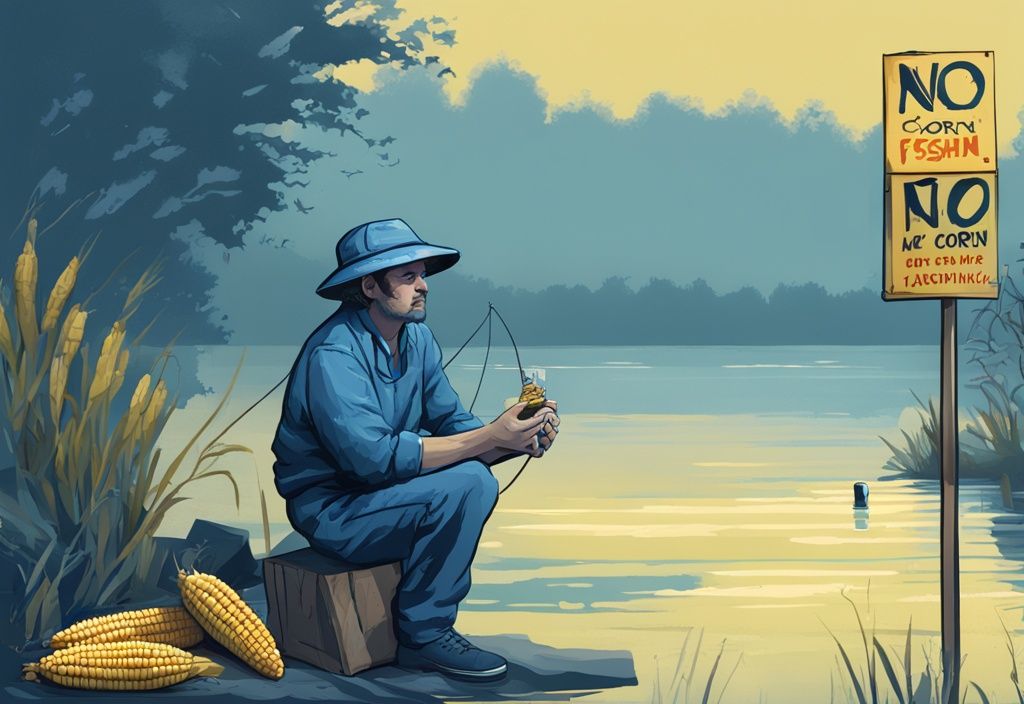
In sum, staying compliant with local fishing codes, continually updating knowledge on fishing regulations, and adopting responsible and eco-friendly practices are not merely legalities but ethical imperatives for any committed angler. Embracing these principles not only enhances the fishing experience but safeguards the delicate balance of our aquatic ecosystems.
Optimize the content with the following guidelines:
1. The content should be written by a fictional persona, to make it sound humanized. Adapt the writing style to match the persona’s perspective and make the content sound human-like: Jake Marlin, an avid angler with over two decades of fishing experience, writes with an authentic, conversational flair that captivates readers of all skill levels. His style is rich in vivid, sensory details that paint a picture of his adventures, making readers feel the sun on their backs and the tug on their lines. He employs a mix of humor and practical wisdom, often weaving personal anecdotes with actionable advice. Jake’s enthusiasm is palpable, and he punctuates his writing with rhetorical questions and relatable musings, inviting readers into a dialogue. His approach is hands-on and encouraging, fostering a sense of camaraderie among fishing enthusiasts. For those curious about what float fishing entails, Jake offers insightful explanations, making the sport accessible to newcomers and veterans alike. Every piece is infused with a deep respect for nature and the joy of the sport, ensuring his content is not just informative but also deeply engaging and uniquely Jake.
2. Ensure that new paragraphs are being used regularly, so the content is easier to read.
3. Ensure heterogeneous sentence length.
4. In case an H2 has no content: Provide the H2 heading with content which introduces what is being covered in its subheadings. Do not greet the reader or talk about yourself in the H2 introduction.
5. Use “Du” instead of “Sie” when talking to the reader
7. Use HTML format for all content creation like for example:
,
- ,
- , etc.
8. Only optimize the Content, do not change anything else. Do not add “Optimized Content:” in front of the optimized content.
9. Do not greet the reader or introduce yourselfProject Details:
Project: FishingAttack.com is an engaging blog that shares expert tips, gear reviews, and personal experiences for fishing enthusiasts. It fosters a community spirit, inspiring both beginners and seasoned anglers to explore diverse fishing styles and locations.
Language: English
FAQ for Fishing with Corn
Understanding the Legality and Impact of Fishing with Corn
Is Corn Baiting Illegal Everywhere?
Fishing with corn isn’t outright illegal everywhere; it’s all about where you’re casting your line. Different states and regions come with their own set of rules. Knowing your local laws is key to avoid any surprise fines that might be lurking in the waters. Take a moment to look up local regulations before you head out. In addition to corn, it’s worth considering the environmental impact of other baits, including soft plastics, which have been shown to release harmful substances into the water.
Why Are There Restrictions on Corn Chumming?
When it comes to chumming with corn, there’s a good reason for those restrictions. Tossing a bunch of corn can really throw off the natural balance. Fish drawn to the easy meal might ignore their usual diet, which messes with the ecosystem. Excessive corn also affects water quality, creating headaches for aquatic life that rely on a balanced environment.
Is Occasional Corn Baiting Harmful to Fish?
Now and then, a fish nibbling on a corn kernel from your hook isn’t a big deal. But frequent corn use can be a different story. Some fish just can’t digest corn well, leading to potential health problems. It’s like giving candy to kids all the time—fun but not healthy. Stick to moderation if you’re going to use corn.
What Are Safer Bait Alternatives to Corn?
If you’re looking for bait that’s kinder to the environment, you have plenty of choices. Worms, insects, and specially designed bait from your local fishing store are all solid picks. These alternatives not only catch fish but also help maintain the natural balance in the water. Better for the fish, better for the planet.
How Do I Check the Regulations in My Area?
Staying compliant with local fishing laws is a breeze if you know where to look. State wildlife agencies are great resources, and don’t overlook official state websites and local fishing guides. Keeping up with the latest regulations not only keeps you out of trouble but also supports sustainable fishing. Everyone wins.
